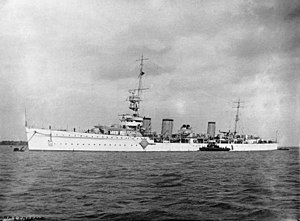| HMS Emerald (D66) | |
|---|---|
 | |
| Career | |
| Name: | HMS Emerald |
| Builder: | Armstrong (Newcastle-on-Tyne, UK) |
| Laid down: | 23 September 1918 |
| Launched: | 19 May 1920 |
| Commissioned: | 14 January 1926 |
| Decommissioned: | 9 June 1948 |
| Out of service: | 15 July 1933 |
| Reclassified: |
In reserve between 1937 to 1939 In reserve between 1945 to 1947 |
| Identification: | Pennant number: D66 |
| Fate: |
Scrapped Handed over to British Steel 23 June 1948 for breaking up Scrapped at Arnott Young (Troon, Scotland), arriving 5 July 1948 |
| General characteristics | |
| Class & type: | Emerald-class light cruiser |
| Displacement: |
7,580 tons standard 9,435 tons full load. |
| Length: | 570 ft (170 m) |
| Beam: | 54.5 ft (16.6 m) |
| Draught: | 16.5 ft (5.0 m) |
| Installed power: | 80,000 shp (59.6 MW) |
| Propulsion: |
Four shafts Brown-Curtis geared turbines Eight boilers in four compartments - part forward of amidships magazine and part abaft forward engine room |
| Speed: | 33 knots (61 km/h) |
| Range: |
1,350 nautical miles at 32 knots (2,500 km at 59 km/h) 8,000 nautical miles at 15 knots (15,000 km at 28 km/h) 1,746 tons fuel oil |
| Complement: | 572 officers and enlisted |
| Armament: |
Original configuration:
August 1939:
April 1943:
April 1944:
|
| Armour: |
Original configuration:
Deck: 1 in (over rudder). |
| Aircraft carried: |
One aircraft with one catapult Catapult later removed. A Fairey Seafox was carried in the early days of World War II |
HMS Emerald was an Emerald-class light cruiser of the Royal Navy. She was built by Armstrong at Newcastle-on-Tyne, with the keel being laid down on 23 September 1918. She was launched on 19 May 1920, and commissioned 14 January 1926.
History[]
Emerald went out to the East Indies, 4th Cruiser Squadron, on commissioning, finally returning home to pay off on 15 July 1933. During her time in the far east she participated as part of a Royal Navy flotilla in the 1927 Nanjing incident, helping to protect British and other international citizens and business interests. After a refit at Chatham, the ship recommissioned for the East Indies again on 31 August 1934, which tour lasted until September 1937, on relief by Liverpool. On her return home she paid off to reserve.
Recommissioned for war service, she joined the 12th Cruiser Squadron on Northern Patrol duties in September 1939. However, the appearance of German raiders in the Atlantic resulted in her transfer to Halifax in October, to escort homeward-bound convoys, where she remained into 1940. Between October 1939 and August 1940 the ship carried £58 million in gold from Britain to Canada (her sister shipped another £10 million) some for Operation Fish. During the early part of the war, until May 1940, her captain was the noted officer, Augustus Agar, V.C..
In 1941 Emerald was transferred to the Indian Ocean, where she escorted troop convoys to the Middle East and stood by in the Persian Gulf during the operations in Iraq in April 1941. After Japan's entry into the war, in December 1941, Emerald joined the Eastern Fleet as part of the 'Fast Group', and in March 1942 was flagship. In August 1942 the ship returned home to refit at Portsmouth in August, and did not return to service until early April 1943.
She rejoined the Eastern Fleet, 4th Cruiser Squadron, for escort duties, then returned home once more for the Invasion of Normandy, when she served with Force "K" in support of Gold Beach. By January 1945 Emerald had joined the reserve fleet and, in 1947, was allocated for ship target trials. As a result of these trials the ship foundered in Kames Bay, Rothesay, on 24 October, and was not refloated until 9 June 1948, after which she was docked, examined, and then handed over to BISCO on 23 June 1948 for breaking up. She was scrapped at Arnott Young (Troon, Scotland) where she arrived on 5 July 1948.
See also[]
- Augustus Agar for more details of her early World War II career.
References[]
- Colledge, J. J.; Warlow, Ben (2006) [1969]. Ships of the Royal Navy: The Complete Record of all Fighting Ships of the Royal Navy (Rev. ed.). London: Chatham Publishing. ISBN 978-1-86176-281-8. OCLC 67375475.
- HMS Emerald at Uboat.net
- Operation Fish, by Alfred Draper, General Publishing Co. Ltd., Don Mills, Ontario, Canada, 1979
| ||||||||
The original article can be found at HMS Emerald (D66) and the edit history here.